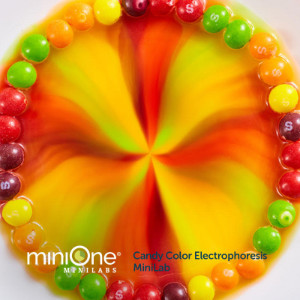Candy Color Electrophoresis MiniLab


Candy Color Electrophoresis MiniLab (Order no. M3009)
System(s) required: Electrophoresis
This fun candy lab helps introduce students in grades 4 – 10 to concepts like gel electrophoresis, electricity, and macromolecules. Includes enough materials for 10 student groups.
Description
You spy a candy dish at a friend’s home and you just have to taste that yummy-looking yellow one. You love lemon! You pop it in your mouth. Oh! No! You hate banana. You can only imagine what weird flavors those other colors may be!
What flavor do you imagine when you think of red? Cherry or apple? What about yellow, green, blue, brown, purple? The color of a piece of food is one of the first things we notice about it, and can make an impact on whether we want it or not. Color masters spend hours formulating the food dye to create the correct color for your food for this very reason!
In this lab, students will explore the phenomenon of candy colors. They will learn how molecular size and electrical charge affect a molecule’s migration, and using their understanding of colors, predict what happens when you use electrophoresis to separate colors from various hard-shell candies. Debate the pros and cons of natural and synthetic food dyes, and explore the colorful history behind food dyes and their regulations! Bring in some candies to test as an inquiry extension! Appropriate for middle school and beginning high school students (grades 4-10).
Materials Included in Each MiniLab
Each MiniLab contains enough materials for 10 workstations, 2 – 3 students per workstation. Materials:
- Ten 1% Agarose gel cups
- One bottle of 100 mL Tris-Borate-EDTA (TBE) buffer concentrate
- One bag of 1.7 mL microcentrifuge tubes
- One bag of 1 – 200 µL micropipette tips
- Dye extraction buffer
- Candies in six colors
- Dye extraction trays
- Teacher guide